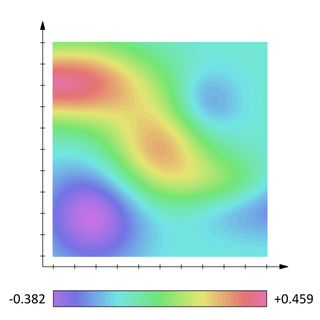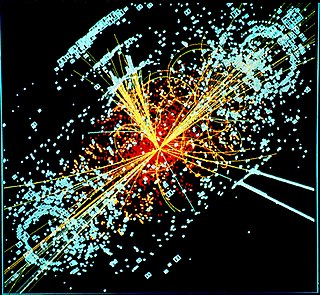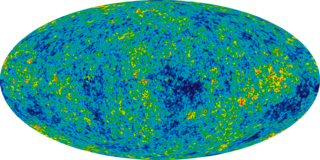
In astrophysics and cosmology scalar field dark matter is a classical, minimally coupled, scalar field postulated to account for the inferred dark matter. [2]

In astrophysics and cosmology scalar field dark matter is a classical, minimally coupled, scalar field postulated to account for the inferred dark matter. [2]
The universe may be accelerating, fueled perhaps by a cosmological constant or some other field possessing long range 'repulsive' effects. A model must predict the correct form for the large scale clustering spectrum, [3] account for cosmic microwave background anisotropies on large and intermediate angular scales, and provide agreement with the luminosity distance relation obtained from observations of high redshift supernovae. The modeled evolution of the universe includes a large amount of unknown matter and energy in order to agree with such observations. This energy density has two components: cold dark matter and dark energy. Each contributes to the theory of the origination of galaxies and the expansion of the universe. The universe must have a critical density, a density not explained by baryonic matter (ordinary matter) alone.
The dark matter can be modeled as a scalar field using two fitted parameters, mass and self-interaction. [4] [5] In this model the dark matter consists of an ultralight particle with a mass of ~10−22 eV when there is no self-interaction. [6] [7] [8] If there is a self-interaction a wider mass range is allowed. [9] The uncertainty in position of a particle is larger than its Compton wavelength (a particle with mass 10−22 eV has a Compton wavelength of 1.3 light years), and for some reasonable estimates of particle mass and density of dark matter there is no point talking about the individual particles' positions and momenta. By some dynamical measurements, we can deduce that the mass density of the dark matter is about . One can calculate the average separation between these particles by deducing the de-Broglie wavelength: , here m is the mass of the dark matter particle and v is the dispersion velocity of the halo. The average number of the particles in cubic volume having the dimension equal to the de Broglie wavelength, is given by,
The occupation number of these particles is so huge that we can consider the wave nature of these particles in the classical description. To satisfy Pauli's exclusion principle the particle must be bosons especially spin zero (scalar) particles, hence these ultra-light dark matter would be more like a wave than a particle, and the galactic halos are giant systems of condensed bose liquid, possibly superfluid. The dark matter can be described as a Bose–Einstein condensate of the ultralight quanta of the field [10] and as boson stars. [9] The enormous Compton wavelength of these particles prevents structure formation on small, subgalactic scales, which is a major problem in traditional cold dark matter models. The collapse of initial over-densities is studied in the references. [11] [12] [13] [14] There are not many models in which we consider dark matter as the scalar field. Axion-like particle (ALP) in string theory can be considered as a model of scalar field dark matter, as its mass density satisfies the relic density of the dark matter. The most common production mechanism of ALP is misalignment mechanism. Which shows the mass around satisfies with the relic abundance of observed dark matter. [15]
This dark matter model is also known as BEC dark matter or wave dark matter. Fuzzy dark matter and ultra-light axion are examples of scalar field dark matter.
Weakly interacting massive particles (WIMPs) are hypothetical particles that are one of the proposed candidates for dark matter.
In physics, quintessence is a hypothetical form of dark energy, more precisely a scalar field, postulated as an explanation of the observation of an accelerating rate of expansion of the universe. The first example of this scenario was proposed by Ratra and Peebles (1988) and Wetterich (1988). The concept was expanded to more general types of time-varying dark energy, and the term "quintessence" was first introduced in a 1998 paper by Robert R. Caldwell, Rahul Dave and Paul Steinhardt. It has been proposed by some physicists to be a fifth fundamental force. Quintessence differs from the cosmological constant explanation of dark energy in that it is dynamic; that is, it changes over time, unlike the cosmological constant which, by definition, does not change. Quintessence can be either attractive or repulsive depending on the ratio of its kinetic and potential energy. Those working with this postulate believe that quintessence became repulsive about ten billion years ago, about 3.5 billion years after the Big Bang.

In mathematics and physics, a scalar field is a function associating a single number to each point in a region of space – possibly physical space. The scalar may either be a pure mathematical number (dimensionless) or a scalar physical quantity.

Technicolor theories are models of physics beyond the Standard Model that address electroweak gauge symmetry breaking, the mechanism through which W and Z bosons acquire masses. Early technicolor theories were modelled on quantum chromodynamics (QCD), the "color" theory of the strong nuclear force, which inspired their name.
An axion is a hypothetical elementary particle originally theorized in 1978 independently by Frank Wilczek and Steven Weinberg as the Goldstone boson of Peccei–Quinn theory, which had been proposed in 1977 to solve the strong CP problem in quantum chromodynamics (QCD). If axions exist and have low mass within a specific range, they are of interest as a possible component of cold dark matter.

In physical cosmology, baryogenesis is the physical process that is hypothesized to have taken place during the early universe to produce baryonic asymmetry, i.e. the imbalance of matter (baryons) and antimatter (antibaryons) in the observed universe.

In theoretical physics, the hierarchy problem is the problem concerning the large discrepancy between aspects of the weak force and gravity. There is no scientific consensus on why, for example, the weak force is 1024 times stronger than gravity.

The Lambda-CDM, Lambda cold dark matter, or ΛCDM model is a mathematical model of the Big Bang theory with three major components:
A strongly interacting massive particle (SIMP) is a hypothetical particle that interacts strongly between themselves and weakly with ordinary matter, but could form the inferred dark matter despite this.

In quantum field theory, a false vacuum is a hypothetical vacuum state that is locally stable but does not occupy the most stable possible ground state. In this condition it is called metastable. It may last for a very long time in this state, but could eventually decay to the more stable one, an event known as false vacuum decay. The most common suggestion of how such a decay might happen in our universe is called bubble nucleation – if a small region of the universe by chance reached a more stable vacuum, this "bubble" would spread.
An exotic star is a hypothetical compact star composed of exotic matter, and balanced against gravitational collapse by degeneracy pressure or other quantum properties.
In astrophysics and particle physics, self-interacting dark matter (SIDM) is an alternative class of dark matter particles which have strong interactions, in contrast to the standard cold dark matter model (CDM). SIDM was postulated in 2000 as a solution to the core-cusp problem. In the simplest models of DM self-interactions, a Yukawa-type potential and a force carrier φ mediates between two dark matter particles. On galactic scales, DM self-interaction leads to energy and momentum exchange between DM particles. Over cosmological time scales this results in isothermal cores in the central region of dark matter haloes.

Christopher T. Hill is an American theoretical physicist at the Fermi National Accelerator Laboratory who did undergraduate work in physics at M.I.T., and graduate work at Caltech. Hill's Ph.D. thesis, "Higgs Scalars and the Nonleptonic Weak Interactions" (1977) contains one of the first detailed discussions of the two-Higgs-doublet model and its impact upon weak interactions. His work mainly focuses on new physics that can be probed in laboratory experiments or cosmology.

In astronomy and cosmology, the dark fluid theory attempt to explain dark matter and dark energy in a single framework, as suggested by cosmologist Alexandre Arbey in 2005. The theory proposes that dark matter and dark energy are not separate physical phenomena, nor do they have separate origins, but that they are strongly linked together and can be considered as two facets of a single fluid. At galactic scales, the dark fluid behaves like dark matter, and at larger scales its behavior becomes similar to dark energy.

In physical cosmology and astronomy, dark energy is a proposed form of energy that affects the universe on the largest scales. Its primary effect is to drive the accelerating expansion of the universe. Assuming that the lambda-CDM model of cosmology is correct, dark energy dominates the universe, contributing 68% of the total energy in the present-day observable universe while dark matter and ordinary (baryonic) matter contribute 26% and 5%, respectively, and other components such as neutrinos and photons are nearly negligible. Dark energy's density is very low: 7×10−30 g/cm3, much less than the density of ordinary matter or dark matter within galaxies. However, it dominates the universe's mass–energy content because it is uniform across space.
The chameleon is a hypothetical scalar particle that couples to matter more weakly than gravity, postulated as a dark energy candidate. Due to a non-linear self-interaction, it has a variable effective mass which is an increasing function of the ambient energy density—as a result, the range of the force mediated by the particle is predicted to be very small in regions of high density but much larger in low-density intergalactic regions: out in the cosmos chameleon models permit a range of up to several thousand parsecs. As a result of this variable mass, the hypothetical fifth force mediated by the chameleon is able to evade current constraints on equivalence principle violation derived from terrestrial experiments even if it couples to matter with a strength equal or greater than that of gravity. Although this property would allow the chameleon to drive the currently observed acceleration of the universe's expansion, it also makes it very difficult to test for experimentally.

Light dark matter, in astronomy and cosmology, are dark matter weakly interacting massive particles (WIMPS) candidates with masses less than 1 GeV. These particles are heavier than warm dark matter and hot dark matter, but are lighter than the traditional forms of cold dark matter, such as Massive Compact Halo Objects (MACHOs). The Lee-Weinberg bound limits the mass of the favored dark matter candidate, WIMPs, that interact via the weak interaction to GeV. This bound arises as follows. The lower the mass of WIMPs is, the lower the annihilation cross section, which is of the order , where m is the WIMP mass and M the mass of the Z-boson. This means that low mass WIMPs, which would be abundantly produced in the early universe, freeze out much earlier and thus at a higher temperature, than higher mass WIMPs. This leads to a higher relic WIMP density. If the mass is lower than GeV the WIMP relic density would overclose the universe.

In cosmology, primordial black holes (PBHs) are hypothetical black holes that formed soon after the Big Bang. In the inflationary era and early radiation-dominated universe, extremely dense pockets of subatomic matter may have been tightly packed to the point of gravitational collapse, creating primordial black holes without the supernova compression typically needed to make black holes today. Because the creation of primordial black holes would pre-date the first stars, they are not limited to the narrow mass range of stellar black holes.
Fuzzy cold dark matter is a hypothetical form of cold dark matter proposed to solve the cuspy halo problem. It would consist of extremely light scalar particles with masses on the order of eV; so a Compton wavelength on the order of 1 light year. Fuzzy cold dark matter halos in dwarf galaxies would manifest wave behavior on astrophysical scales, and the cusps would be avoided through the Heisenberg uncertainty principle. The wave behavior leads to interference patterns, spherical soliton cores in dark matter halo centers, and cylindrical soliton-like cores in dark matter cosmic web filaments.
Céline Bœhm is a professor of Particle Physics at the University of Sydney. She works on astroparticle physics and dark matter.